Final report for FNC17-1071
Project Information
Don Brown BS, Fresno, Ohio. Don has over twenty years of experience with all phases of artificial insemination (AI) in horses. Don retired from an agricultural education and extension career, and continues working with farmers as a USDA crop loss adjuster. As a participant in the previously described SARE Grant # FNC13-901, he is fully aware of the ram semen preservation issues identified at that time, and has a definite plan for solving those issues. He will manage this project on his forty-acre farm, where he owns and promotes a forty ewe, three ram flock of heritage breed Blue Faced Leicester and Lincoln Long-wool sheep. The farm is divided into ten rotational pastures, and he is aided in flock management by a guard llama, donkey, and working stock dog. Don will also arrange and perform live education outreach regarding project conclusions.
Other Participants
Anne Brown BSN, RN, Fresno, Ohio. Anne is Don’s wife, and has shared his twenty years of experience in equine artificial insemination (AI) as the technician who collected, evaluated, extended and shipped the semen samples. She also participated in the previously described SARE Grant project, as the ram semen handler and evaluator. She is a BSN prepared Registered Nurse. She will participate in this current grant project by performing flock health management, and again collecting, evaluating, extending and chilling the semen samples. Furthermore, she will perform the successive chilled semen motility evaluations for each sample. Anne will be responsible for maintaining accurate records and drafting the written reports and articles for outreach publication.
Cody Brown, Fresno, Ohio. Cody is the twenty-eight year old son of Don and Anne, and currently carries out the daily chores and heavy work required on the farm. He will participate as hired labor during this proposed project. As a lifelong livestock handler, Cody has developed an effective, minimally stressing technique for handling this flock, and will be a great asset in the humane care of the animals throughout the project.
Betsy Hodge MS-BS, Regional Livestock Educator, Cornell University Extension Service, NY. Betsy Hodge leads a group of Extension Educators from across northern New York State, focusing largely on issues facing sheep and goat producers. She provides programs on all areas of production, from nutrition and rotational grazing to handling, marketing, and parasite management. Over the past year, she has been networking with Don and Anne on the specific issues faced with artificial insemination in sheep. Ms. Hodge has written a Letter of Support for this grant proposal, and anticipates incorporating the findings into her own research protocol. Ms. Hodge will also participate in the second year as an independent semen evaluator of an actual chilled shipped sample from the final collection of this project.
Craig Zimmerly DVM, Apple Creek, Ohio. Dr. Zimmerly graduated from the Ohio State University School of Veterinary Medicine in 2010. He has been involved in sheep production for many years, with a strong interest in AI and ultrasound. Dr. Zimmerly was also a participant in the previously described SARE grant, and therefore is personally acquainted with the semen issues identified at that time. He will contribute to this proposed project by performing the breeding soundness exams on the rams, and sharing his ideas on solving the identified issues.
James A. Weber Ph.D. DVM is an Associate Professor of Animal and Veterinary Sciences at the University of Maine. Dr. Weber has co-authored 3 published research papers, and is currently involved in research on ovine semen preservation. Dr. Weber is participating as a collaborator on collection, evaluation and preservation techniques, as well as providing independent analysis of an actual shipped sample from the final collection of this project.
The focus of this project is to obtain a series of ram semen samples collected by artificial vagina on a phantom ewe. These samples will be evaluated in 3 commercial semen extenders, then chilled and re-evaluated at 24 hour increments. The purpose is to identify effective ram semen handling methods and optimal chilled extension media, to make chilled shipped semen an available resource to small sheep ranchers.
The primary resulting issue discovered in the first year of this project, 2017,was difficulty in convincing the rams to mount the phantom and ejaculate into an artificial vagina (AV). Numerous re-configurations of AV, phantom and venue were attempted, without reliable ram performance attained.
After consultation with other researchers and sheep producers, further protocol adjustments are planned for year two of this project.
The results of these adjustments were as follows. Regardless of the availability of appropriately cycling (hot) ewes, we were not successful in convincing the rams to mount the phantom. We were, however, consistently successful at collecting the 2 adult rams by hand-held artificial vagina over a jump ewe, in the breeding chute. The 8-month old ram refused collection at this time. The collected semen was maintained at 100 degrees F in a warmed cooler for transport to the warm room, and placed in an incubator also maintained at 100 F. Volume of ejaculate was recorded, gross progressive motility was determined via microscopic examination, and morphology examined, with defects recorded. Concentration was measured via Quick Check-Canine Semen Management System device (see photo evidence). Samples from each ram were divided and extended to a 4:1 ratio of extender to raw semen, totaling a 1mL dose, then placed in a foam buffer tube, inside a Canine Express Chilled shipping container, to await 24, 48 and 72 hour progressive motility evaluations. Three commercial extenders were chosen from data discovered during the previous project # FNC13-901 and year 1 of this current project. These were INRA-96 Stallion semen extender from IMV Technologies, BotuSemen equine semen extender from Botu Pharma, USA, and Next Generation Universal Formula semen extender with amikacin and K-Penn antibiotic additives, from Exodus Breeders corporation. By collecting 2 rams over 5 cycles, we evaluated 10 samples in each of the 3 study extenders.

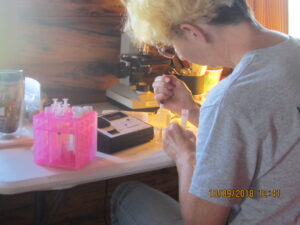
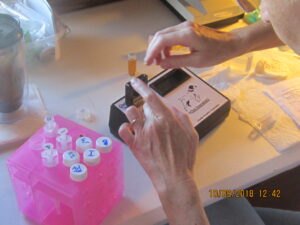
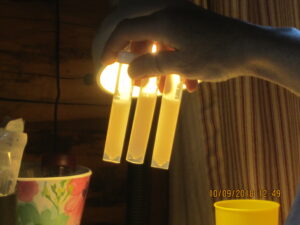
Since the original objective of this project was to evaluate ram semen, it was essential to first identify a reliable method for collection of clean catch semen samples.
The second year proposal was adjusted to include further modifications to the phantom, and utilized three ewes for rotating forced estrous to ensure the availability of "hot" ewes at required collection times. The phantom was further modified by inserting the AV into the phantom, eliminating the distraction of a handler between the ram and phantom.
In year two of this project, 2018, further adjustments refined the phantom. The body was angled to drop the hind end by 15 degrees to more accurately simulate a mounted ewe, the rear supports were shortened so the ram would not stumble on them, and a smooth-edged funnel was secured in the opening for the AV, to guide the penis into the AV.
Three vet approved ewes had CIDR's inserted vaginally with removal and PG-600 shots utilized per protocol to ensure effective tease ewe availability which should entice rams to mount phantom and ejaculate reliably into AV. [Editor's Note: CIDR stands for Controlled Internal Drug Release -- an intravaginal progesterone insert used to synchronize estrus.]
Cycling ewes were assured by choosing 4 proven calm, fertile ewes whose cycles were manipulated through the use of intravaginal CIDR devices and PG-600 injections. By rotating these ewes through cycles every two weeks, we were assured two receptive ewes available as teasers for every 14-day collection cycle. On day 1, CIDR's were inserted in 2 ewes using clean technique per protocol. On day 13, the CIDR's were removed and 2mL PG-600 administered IM. At the same time, CIDR's were cleanly inserted in the other 2 ewes, in preparation for the next cycle collection. This rotation was effective at maintaining "hot" ewes on each collection date. Since the rams were occasionally picky about which ewe they wanted, we always had two prepared to choose from.
Cooperators
- (Educator)
- (Educator and Researcher)
Research
Year 1: In order to obtain clean catch semen samples for evaluation, a controlled collection environment/procedure was needed. This project collaborated with information previously collected from Betsy Hodge and her research team at Cornell University Sheep Research Station.
A phantom ewe was constructed to simulate the size, shape and angle of a receptive breeding ewe. See photo #1. This was first placed between two ewes in a head-gate who were displaying heat, and the ram was pushed onto the phantom as he rose to mount the desired ewe. The first phantom design was too long, as the ram had to back up to mount and lost his erection. See photo #2. The phantom was shortened, to no avail. All rams lost erections in this process, possibly due to distraction. See photo #3.
Ewes and phantom were then moved into a breeding chute, to minimize distraction. See photo #4. All rams mounted but collection was hampered by the need for the collector to reach through the wall window to get the penis into the AV. This also broke the chain of arousal and was ineffective at collection.
Cushioning on phantom was increased to more accurately simulate ewe. See photo #5.
Commercial deer/doe pheromone was applied to phantom without stimulating arousal.
Urine collected from ewes in estrus was applied to the phantom, which stimulated mounting, but not ejaculation.
AV was inserted into back of phantom to eliminate interference by collector, but by this point, researchers were out of "hot" ewes.
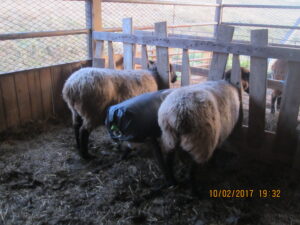
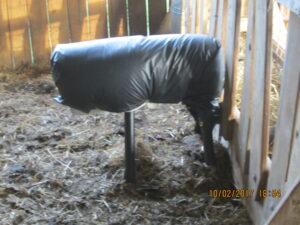
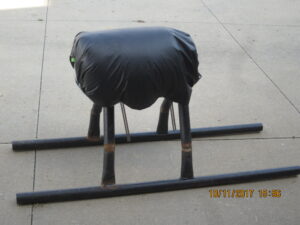
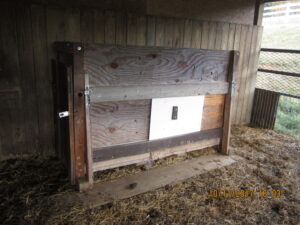
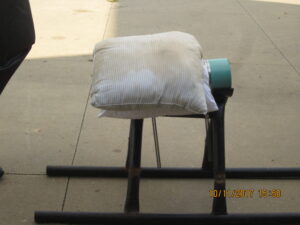

Year 2: Adjustments to the phantom and details of provision for "hot" ewes at all 5 collection dates have been described in the above Summary and Project Objectives sections.
Year 1: Results of the first year of this project identified specific areas needing improvement. To facilitate sufficient ram arousal, a consistent supply of ewes in full heat will be required. To facilitate collection while ram is mounted on phantom, the end plate holding the AV will be adjusted to a more funnel-like shape, to guide the penis reliably into the AV. Presence of a ewe in full estrus was effective in facilitating ram semen collection in project #FNC13-901, providing encouragement that this may also facilitate collection in this project.
Year 2: All of the above alterations to the phantom were performed with the result that the 2 older rams would sporadically mount, but not long enough to enter the AV or ejaculate. The 8 month old ram would do neither, and was eliminated from the study for non-performance. The rams were, however, eager to mount the study ewes, and collection was reliably performed by manual deflection of the erect penis into the AV, while the ram was settled on the hot ewe in the breeding chute. All 10 study collections were performed using this method.
Rams were randomly selected in a convenience sample of all rams with passing breeding soundness exams (BSE) as performed by the participating veterinarian. Selection criteria included the passing score, which measured vital signs within normal limits, clear eyes with full vision, sound feet, clear lungs and normal heart rhythm. Scrotal circumference, testicular texture, and potential tubular defects were evaluated. Three rams passed this test. Further inclusion criteria included rams undergoing acclimation to the breeding chute and phantom, and training to handle on a collar and lead. Finally, study rams had to be willing to mount either the phantom or tease ewe. The young ram failed this last criteria, as stated above. Further preparations included clipping the belly and legs of the rams and crutching of the ewes, to facilitate clean catch of semen.
Semen evaluation results:
9/10/18: Winston: volume 0.75 mL, motility 95%, morphology 95% concentration 9.9 billion/ mL
Kevlar: volume 0.25 mL motility 0 morphology 0 concentration 0 sperm cells (jumped fast, missed ejaculate)
24 hr eval: Winston: Amikacin + K-Penn 80% Inra-96 100% vibrant BotuSemen 90% vibrant
48 hr eval: Winston: A+KPenn 40% Inra 96 95% Botu 85%
72 hr eval: Winston: A+KPenn 10% Inra 96 55% Botu 40%
9/25/18: Winston: volume 2.0 mL motility 98% morphology 90% concentration 9.9 bill/mL
Kevlar: volume 2.0 mL motility 85% morphology 95% concentration 13.16 bill/mL
24 hr eval: Winston: A+KPenn 90% Inra 99% Botu 80%
Kevlar: A+KPenn 80% Inra 80% Botu 85%
48 hr eval: Winston: A+KPenn 40% Inra 90% Botu 55%
Kevlar: A+KPenn 20% Inra 70% Botu 25%
72 hr eval: All dead
10/9/18: Winston: volume 2.5 mL motility 0 (got chilled) morphology 0 concentration not measured
Kevlar: volume 1.2 mL motility 75% morphology 50% concentration 0.417 bill/mL
24 hr eval: Kevlar: A+KPenn 10% Inra 85% Botu 70%
48 hr eval: Kevlar: A+KPenn 5% Inra 45% Botu 50%
72 hr eval: all dead
11/22/18: Winston: volume 3 mL motility 50% sluggish morphology 90% concentration 0.96 bill/mL
Kevlar: volume 1.5 mL motility 98% vibrant morphology 98% concentration 4.3 bill/mL
24 hr eval: Winston: all dead
Kevlar: A+KPenn 85% Inra 95% Botu 60%
48 hr eval: Kevlar: A+KPenn 30% Inra 75% Botu 45%
72 hr eval: Kevlar: A+KPenn 20% Inra 75% Botu 30%
11/7/18: Winston: volume 2mL motility 90% morphology 98% concentration 8.49 bill/mL
Kevlar: volume 2 mL motility 98% morphology 92% concentration 2.58 bill/mL
24 hr eval: Winston: A+KPenn 0 Inra 40% Botu 0
Kevlar: A+KPenn 25% Inra 85% vibrant Botu 80%
48 hr eval: Winston: A+KPenn 10% Inra 40% Botu 0
Kevlar: A+KPenn 20% Inra 80% Botu 60%
72 hr eval: Winston: all dead
Kevlar: A+KPenn 10% Inra 65% Botu 45%
Extended samples of both rams in all 3 extenders from the 11/7/18 collection were shipped, as described earlier per protocol, via UPS. to Betsy Hodge and James Weber. These professional researchers performed 24 and 48 hour progressive motility analyses, with results very similar to those described above. All 3 of us agreed with accuracy of the independent data obtained, and with the conclusion that Inra 96 was the best performing extender media in this study.
Educational & Outreach Activities
Participation Summary:
No formal outreach activities were performed during year 1 of this project, due to lack of research data, however, informal conversations have taken place continually throughout that research period, both gathering ideas on phantom design and ram collection techniques. These have been conducted in person, over the phone, and via email.
During year 2 of this project, Don Brown performed numerous farm visits to discuss the benefits and viability of shipping high-quality semen in to synchronized ewes for artificial insemination, as well as the benefits of increased ram potential value when shipping semen out to other farms. He collaborated in person, by phone and e-mail with other agricultural professionals, such as Rory Lewandowski and Jeff McCutcheon of the Ohio Agricultural Extension services, Roger High, Leah Miller, Kathy Bielek and Bob Hendershot, as leaders in sheep research, symposiums and seminar education in Ohio, and area shepherds.
Now that research data and methods have been analyzed, formal dissemination and outreach can proceed. This NCR-SARE report will be publicly available on federal, state, regional and local levels. An article describing the study research, methods, drawbacks and recommendations will be submitted locally in Just Plain Values, a popular journal with local shepherds. This article will also be submitted to The Shepherd magazine, and regionally to The Farm & Dairy agricultural newspaper.
Learning Outcomes
Throughout the process of designing, implementing and evaluating this study, we have learned how to better utilize information resources such as other agricultural professionals, sheep association representatives, and government supporting bodies like NCR-SARE. The discovery of Betsy Hodge and her ram/AI projects at Cornell University has given us a strong collaborator. This is also true of James Weber Ph.D. DVM of the University of Maine. Dr. Weber is now the 4th contributing veterinarian to this topic, and his and Ms Hodge's willingness to provide independent, professional chilled shipped semen evaluation has provided credibility through triangulation to the above results.
The formal summary conclusion to this study is that of the three semen extenders used, Inra 96 is superior in boosting vitality and nourishing longevity chilled ram semen. While the BotuSemen also facilitated over 50% progressive motility over a 48 hour chill period, the Universal Formula with amikacin and K-Penn performed poorly.
Methodology demonstrated the need for estrous manipulation of at least two jump ewes to ensure sufficient arousal in the rams for reliable collections. The CIDR and PG-600 protocol was effective and reliable for producing timely cycling in these ewes. Further research needs to be performed to identify a phantom configuration that the rams would be willing to mount and breed.
This study was limited by the low number of rams available, and the small number of collection samples evaluated. A more comprehensive study using more rams representing a wider variety of breeds, more collection samples for evaluation, and a larger representation of extender media is recommended.
When asked by other farmers about the viability of collecting their rams for chilled shipped semen, I would encourage them regarding the positive results we had with Inra 96 as a reliable, cost effective, and easy to use ram semen extender. I would also provide them with resource contact information to fully educate them on sheep management practices to facilitate this activity, and sources of the necessary specialized equipment. Further, I would offer to consult with them on any facility alterations needed, and teach them the specialized techniques for BSE, semen collection, evaluation, extension and chilled shipment.
Project Outcomes
This researcher identifies a need for further development of semen collection techniques for rams including collection facility design to enhance focus and reduce distraction, and phantom design improvements.
At this time, this researcher is confident in recommending Inra 96 as an effective ram semen extender. I believe a larger study with more semen samples and extenders sourced from Europe, Australia and New Zealand be included in a comparison trial. Also, further studies are recommended to provide validity to the study results. Further questions to explore might ask if semen sensitivity or hardiness varies between breeds.